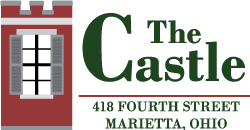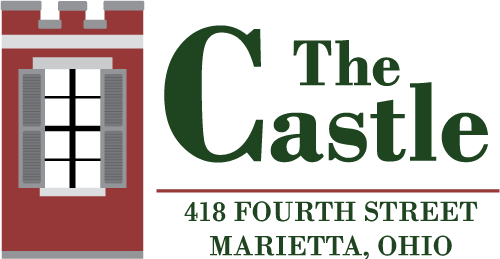
Our third entry is from Castle archaeologist and collections manager Wes Clarke. Wes was born where the Treaty of Greenville was signed and lived in seven different Ohio towns before completing high school. He has undergraduate degrees in anthropology from Miami University and Prescott College, and Master’s degrees from Marietta College (history and archaeology) and Ohio University (Southeast Asian history and archaeology). Wes also has a strong interest in art history and spent a couple years in graduate school at The Ohio State University studying Asian art history.
 Wes is a Register Professional Archaeologist and has worked on projects in the American Midwest and Southeast Asia for over 45 years, including field research for Miami University, the University of Tennessee, Ohio Historical Society, Cleveland Museum of Natural History, Michigan History Division, Marietta College, and the Ohio Department of Transportation. When Wes came to work at The Castle in 2013, he instituted an archaeological program to investigate the early 19th century Nathaniel Clark family pottery site located on The Castle grounds that is on-going.
Wes is a Register Professional Archaeologist and has worked on projects in the American Midwest and Southeast Asia for over 45 years, including field research for Miami University, the University of Tennessee, Ohio Historical Society, Cleveland Museum of Natural History, Michigan History Division, Marietta College, and the Ohio Department of Transportation. When Wes came to work at The Castle in 2013, he instituted an archaeological program to investigate the early 19th century Nathaniel Clark family pottery site located on The Castle grounds that is on-going.
You can view and (if so inclined) download some of Wes’ recent Ohio and Southeast Asian archaeology publications at https://ohio.academia.edu/WesleyClarke
If you decide to order any of the recommendations below online, please consider supporting us by selecting “Betsey Mills Corporation” in Amazon Smile. Thank you and happy reading!
History at Home: Recommendations from The Castle’s Archaeologist
Prehistoric Midwestern Archaeology
Ancient Monuments of the Mississippi Valley: Comprising the Results of Extensive Original Surveys and Explorations, by E. G. Squier and E. H. Davis, 1848. There is no better place to start an inquiry into the mounds and earthworks of the American Midwest than this book, the first publication of the Smithsonian Institution. Squier and Davis operated out of Chillicothe, Ohio, and much of this work is focused on Ohio sites, providing detailed plans and measurements (even if some of this information is now known to be inaccurate). The first illustration in this publication is an engraving of the earthworks at Marietta. An original copy is quite expensive, but affordable reprints are available.
The Mound Builders of Ancient America: The Archaeology of a Myth, by Robert Silverberg, 1986. This book relates the speculations that developed historically about who created the mounds and earthworks found across eastern North America by European and American settlers. These ideas were often based on the presumption that “primitive” Native Americans could not have built these elaborate structures, and that a “lost race” of superior culture was the source for these constructions. This highly readable account illustrates how the biases of observers can lead to fanciful explanations with sometimes tragic consequences.
Hidden Cities: The Discovery and Loss of Ancient North American Civilization, by Roger G. Kennedy, 1994. This is another very readable book, an update in many respects to the story told by Robert Silverberg (see above). Kennedy, who has been the director of the National Park Service and the Smithsonian’s American History Museum, not only reviews the mis-representation of prehistoric sites and their creators in North America, but seeks to give the achievements of Native American cultures their proper place in a global context of human accomplishment.
Ohio Archaeology: An Illustrated Chronicle of Ohio’s Ancient American Indian Culture, by Bradley T. Lepper, 2005. There is never uniform agreement among archaeologists about dates and interpretations, but Lepper’s book offers a reasonable overview of the 12,000+ year record of prehistoric Native American cultures in the Ohio region. Profusely illustrated and with many specialized sidebars by other scholars, this book is a great introduction to the topic and points the reader to additional sources of information.
The Archaeology of Ancient North America, by Timothy R. Pauketat and Kenneth E. Sassaman, 2020. This is a new publication that covers the entire North American continent, with substantial discussion of the Midwest’s prehistoric heritage. No general survey like this will satisfy the expectations of regional specialists, but this profusely illustrated book is an approachable summary of a vast topic.
Stone Age Spear and Arrow Points of the Midcontinental and Eastern United States: A Modern Survey and Reference, by Noel D. Justice, 1988/2009. If you are interested in identifying the age and geographical distribution of flaked stone artifacts, this is a widely used reference. It takes a systematic approach to describing and illustrating the different types of projectile points that have been found and dated through careful archaeological investigation. Even used copies of this book tend to be expensive; hopefully you can find one at a nearby library.
Historical Archaeology in America
In Small Things Forgotten: An Archaeology of Early American Life, by James Deetz, revised 1996. This is a “classic” reference in the field of historical archaeology, which differs to some extent from prehistoric investigation, particularly in the availability of written documentation to help understand the material record in the ground. Although widely used for college courses in a variety of disciplines, this book is reader-friendly even for the non-specialist.
Books by Ivor Noel Hume: (for example) Historical Archaeology (1968), A Guide to the Artifacts of Colonial America (1969), All the Best Rubbish (1974), Discoveries at Martin’s Hundred (1983), and If These Pots Could Talk (2001). Noel Hume was for many years the director of Colonial Williamsburg’s archaeological research program and an early proponent in the United States of ground-borne material remains as an important source of information on historical sites, people and events. His books are useful to both the specialist and the general reader.

